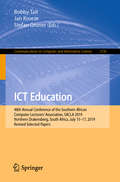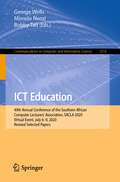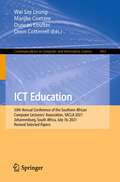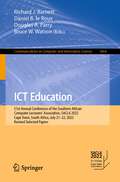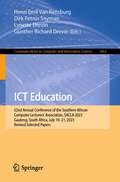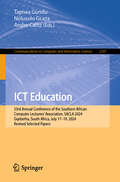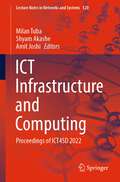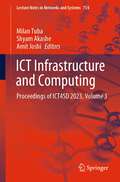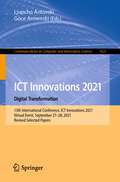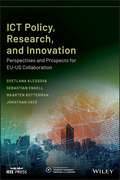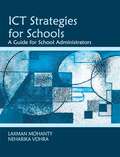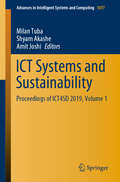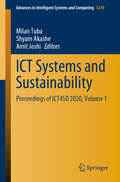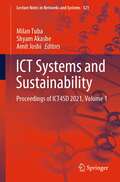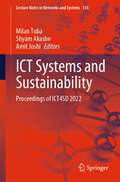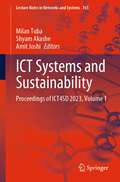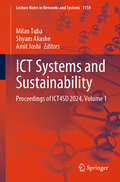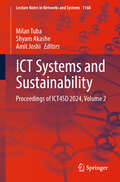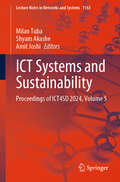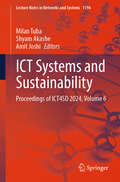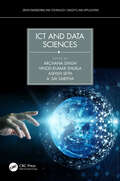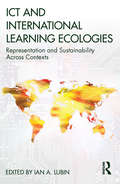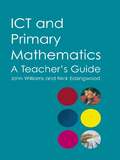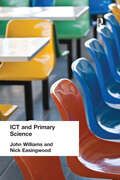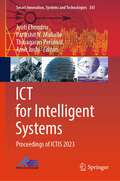- Table View
- List View
ICT Education: 48th Annual Conference of the Southern African Computer Lecturers’ Association, SACLA 2019, Northern Drakensberg, South Africa, July 15–17, 2019, Revised Selected Papers (Communications in Computer and Information Science #1136)
by Stefan Gruner Bobby Tait Jan KroezeThis book constitutes the refereed proceedings of the 48th Annual Conference of the Southern African Computer Lecturers' Association on ICT Education, SACLA 2019, held in Northern Drakensberg, South Africa, in July 2019. The 16 revised full papers presented were carefully reviewed and selected from 57 submissions. The papers are organized in following topical sections: computer programming education; system security education; software engineering education; education of post-graduate research-students; our students, our profession.
ICT Education: 49th Annual Conference of the Southern African Computer Lecturers' Association, SACLA 2020, Virtual Event, July 6–9, 2020, Revised Selected Papers (Communications in Computer and Information Science #1518)
by Bobby Tait George Wells Monelo NxoziThis book constitutes the refereed proceedings of the 49th Annual Conference of the Southern African Computer Lecturers' Association on ICT Education, SACLA 2019, held in a virtual mode in South Africa, in July 2020. The 13 revised full papers presented were carefully reviewed and selected from 55 submissions. The papers focus on practical experiences in computing education, novel tools for learning and/or assessment, and research investigating aspects of computing education.
ICT Education: 50th Annual Conference of the Southern African Computer Lecturers' Association, SACLA 2021, Johannesburg, South Africa, July 16, 2021, Revised Selected Papers (Communications in Computer and Information Science #1461)
by Marijke Coetzee Wai Sze Leung Duncan Coulter Deon CotterrellThis book constitutes the refereed proceedings of the 50th Annual Conference of the Southern African Computer Lecturers' Association on ICT Education, SACLA 2021, held in Johannesburg, South Africa in July 2021. The 9 revised full papers presented were carefully reviewed and selected fromthe 23 submissions. One invited paper was also included in this volume. The papers are organized in following topical sections: past, present and future; teaching innovation; teaching methods and strategies.
ICT Education: 51st Annual Conference of the Southern African Computer Lecturers' Association, SACLA 2022, Cape Town, South Africa, July 21–22, 2022, Revised Selected Papers (Communications in Computer and Information Science #1664)
by Bruce W. Watson Richard J. Barnett Daniel B. le Roux Douglas A. ParryThis book constitutes the refereed proceedings of the 51st Annual Conference of the Southern African Computer Lecturers' Association, SACLA 2022, held in Cape Town, South Africa, during July 21–22, 2022.The 10 full papers were included in this book were carefully reviewed and selected from 31 submissions. They were organized in topical sections as follows: curriculum; assessment; teaching in context; innovative teaching; and pandemic pedagogy.
ICT Education: 52nd Annual Conference of the Southern African Computer Lecturers' Association, SACLA 2023, Gauteng, South Africa, July 19–21, 2023, Revised Selected Papers (Communications in Computer and Information Science #1862)
by Lynette Drevin Henri Emil Van Rensburg Dirk Petrus Snyman Günther Richard DrevinThis book constitutes the refereed proceedings of the 52nd Annual Conference of the Southern African Computer Lecturers' Association on ICT Education, SACLA 2023, held in Gauteng, South Africa, during July 19–21, 2023. The 12 full papers included in this book were carefully reviewed and selected from 42 submissions. They were organized in topical sections as follows: student centered teaching and learning; AI and future movements; programming; and beyond the classroom.
ICT Education: 53rd Annual Conference of the Southern African Computer Lecturers' Association, SACLA 2024, Gqeberha, South Africa, July 17–19, 2024, Revised Selected Papers (Communications in Computer and Information Science #2397)
by Tapiwa Gundu Noluxolo Gcaza Andre CalitzThis book constitutes the refereed proceedings of the 53rd Annual Conference of the Southern African Computer Lecturers' Association on ICT Education, SACLA 2024, held in Gqeberha, South Africa, during July 17–19, 2024. The 10 full papers included in this book were carefully reviewed and selected from 53 submissions. The SACLA 2024 conference served as a distinguished platform for exchanging original research and practical experiences, fostering dialogue on the teaching and learning of Information Systems, Computer Science, Information Technology and related disciplines.
ICT Infrastructure and Computing: Proceedings of ICT4SD 2022 (Lecture Notes in Networks and Systems #520)
by Amit Joshi Shyam Akashe Milan TubaThis book proposes new technologies and discusses future solutions for ICT design infrastructures, as reflected in high-quality papers presented at the 7th International Conference on ICT for Sustainable Development (ICT4SD 2022), held in Goa, India, on 29–30 July 2022. The book covers the topics such as big data and data mining, data fusion, IoT programming toolkits and frameworks, green communication systems and network, use of ICT in smart cities, sensor networks and embedded system, network and information security, wireless and optical networks, security, trust, and privacy, routing and control protocols, cognitive radio and networks, and natural language processing. Bringing together experts from different countries, the book explores a range of central issues from an international perspective.
ICT Infrastructure and Computing: Proceedings of ICT4SD 2023, Volume 3 (Lecture Notes in Networks and Systems #754)
by Amit Joshi Shyam Akashe Milan TubaThis book proposes new technologies and discusses future solutions for ICT design infrastructures, as reflected in high-quality papers presented at the 8th International Conference on ICT for Sustainable Development (ICT4SD 2023), held in Goa, India, on August 3–4, 2023. The book covers the topics such as big data and data mining, data fusion, IoT programming toolkits and frameworks, green communication systems and network, use of ICT in smart cities, sensor networks and embedded system, network and information security, wireless and optical networks, security, trust, and privacy, routing and control protocols, cognitive radio and networks, and natural language processing. Bringing together experts from different countries, the book explores a range of central issues from an international perspective.
ICT Innovations 2021. Digital Transformation: 13th International Conference, ICT Innovations 2021, Virtual Event, September 27–28, 2021, Revised Selected Papers (Communications in Computer and Information Science #1521)
by Ljupcho Antovski Goce ArmenskiThis book constitutes the refereed proceedings of the 13th International ICT Innovations Conference, ICT Innovations 2021, held as virtual event in September 2021.The 15 full papers presented were carefully reviewed and selected from 58 submissions. The papers are organized in topical sections on deep learning and AI; NLP and social network analysis; theoretical foundations and information security; e-services; sensor systems, IoT.
ICT Policy, Research, and Innovation: Perspectives and Prospects for EU-US Collaboration (IEEE Press Series on Technology Management, Innovation, and Leadership)
by Jonathan Cave Sebastian Engell Svetlana Klessova Maarten BottermanA comprehensive discussion of the findings of the PICASSO initiative on ICT policy ICT Policy, Research, and Innovation: Perspectives and Prospects for EU-US Collaboration provides a clearly readable overview of selected information and communication technology (ICT) and policy topics. Rather than deluge the reader with technical details, the distinguished authors provide just enough technical background to make sense of the underlying policy discussions. The book covers policy, research, and innovation topics on technologies as wide-ranging as: Internet of Things Cyber physical systems 5G Big data ICT Policy, Research, and Innovation compares and contrasts the policy approaches taken by the EU and the US in a variety of areas. The potential for future cooperation is outlined as well. Later chapters provide policy perspectives about some major issues affecting EU/US development cooperation, while the book closes with a discussion of how the development of these new technologies is changing our conceptions of fundamental aspects of society.
ICT Strategies for Schools: A Guide for School Administrators
by Laxman Mohanty Neharika VohraRecognizing the potential of ICTs to make the classroom transaction of curriculum significantly more relevant and purposeful, principals and school administrators in India need to design appropriate IT strategies and oversee the entire implementation process in their schools. This book is guide to the use of ICT in schools, covering issues of pedagogy, curriculum and learning. In brief, it deals with - Education uses of IT - Criteria for selection of hardware and software - Designing an IT-assisted curriculum - Teacher recruitment, training and desired competencies - Management and financial issues - Possible problem areas: plagiarism, privacy, hacking Lucidly written, with case studies highlighting successful strategies, this volume will be of immense importance to principals and administrators of schools as also students of education.
ICT Systems and Sustainability: Proceedings of ICT4SD 2019, Volume 1 (Advances in Intelligent Systems and Computing #1077)
by Amit Joshi Shyam Akashe Milan TubaThis book proposes new technologies and discusses future solutions for ICT design infrastructures, as reflected in high-quality papers presented at the 4th International Conference on ICT for Sustainable Development (ICT4SD 2019), held in Goa, India, on 5–6 July 2019. The conference provided a valuable forum for cutting-edge research discussions among pioneering researchers, scientists, industrial engineers, and students from all around the world. Bringing together experts from different countries, the book explores a range of central issues from an international perspective.
ICT Systems and Sustainability: Proceedings of ICT4SD 2020, Volume 1 (Advances in Intelligent Systems and Computing #1270)
by Amit Joshi Shyam Akashe Milan TubaThis book proposes new technologies and discusses future solutions for ICT design infrastructures, as reflected in high-quality papers presented at the 5th International Conference on ICT for Sustainable Development (ICT4SD 2020), held in Goa, India, on 23–24 July 2020. The conference provided a valuable forum for cutting-edge research discussions among pioneering researchers, scientists, industrial engineers, and students from all around the world. Bringing together experts from different countries, the book explores a range of central issues from an international perspective.
ICT Systems and Sustainability: Proceedings of ICT4SD 2021, Volume 1 (Lecture Notes in Networks and Systems #321)
by Amit Joshi Shyam Akashe Milan TubaThis book proposes new technologies and discusses future solutions for ICT design infrastructures, as reflected in high-quality papers presented at the 6th International Conference on ICT for Sustainable Development (ICT4SD 2021), held in Goa, India, on 5–6 August 2021. The book covers the topics such as big data and data mining, data fusion, IoT programming toolkits and frameworks, green communication systems and network, use of ICT in smart cities, sensor networks and embedded system, network and information security, wireless and optical networks, security, trust, and privacy, routing and control protocols, cognitive radio and networks, and natural language processing. Bringing together experts from different countries, the book explores a range of central issues from an international perspective.
ICT Systems and Sustainability: Proceedings of ICT4SD 2022 (Lecture Notes in Networks and Systems #516)
by Amit Joshi Shyam Akashe Milan TubaThis book proposes new technologies and discusses future solutions for ICT design infrastructures, as reflected in high-quality papers presented at the 7th International Conference on ICT for Sustainable Development (ICT4SD 2022), held in Goa, India, on 29–30 July 2022. The book covers the topics such as big data and data mining, data fusion, IoT programming toolkits and frameworks, green communication systems and network, use of ICT in smart cities, sensor networks and embedded system, network and information security, wireless and optical networks, security, trust, and privacy, routing and control protocols, cognitive radio and networks, and natural language processing. Bringing together experts from different countries, the book explores a range of central issues from an international perspective.
ICT Systems and Sustainability: Proceedings of ICT4SD 2023, Volume 1 (Lecture Notes in Networks and Systems #765)
by Amit Joshi Shyam Akashe Milan TubaThis book proposes new technologies and discusses future solutions for ICT design infrastructures, as reflected in high-quality papers presented at the 8th International Conference on ICT for Sustainable Development (ICT4SD 2023), held in Goa, India, on 3–4 August 2023. The book covers the topics such as big data and data mining, data fusion, IoT programming toolkits and frameworks, green communication systems and network, use of ICT in smart cities, sensor networks and embedded system, network and information security, wireless and optical networks, security, trust, and privacy, routing and control protocols, cognitive radio and networks, and natural language processing. Bringing together experts from different countries, the book explores a range of central issues from an international perspective.
ICT Systems and Sustainability: Proceedings of ICT4SD 2024, Volume 1 (Lecture Notes in Networks and Systems #1159)
by Amit Joshi Shyam Akashe Milan TubaThis book proposes new technologies and discusses future solutions for ICT design infrastructures, as reflected in high-quality papers presented at the 8th International Conference on ICT for Sustainable Development (ICT4SD 2024), held in Goa, India, on 8–9 August 2024. The book covers the topics such as big data and data mining, data fusion, IoT programming toolkits and frameworks, green communication systems and network, use of ICT in smart cities, sensor networks and embedded system, network and information security, wireless and optical networks, security, trust, and privacy, routing and control protocols, cognitive radio and networks, and natural language processing. Bringing together experts from different countries, the book explores a range of central issues from an international perspective.
ICT Systems and Sustainability: Proceedings of ICT4SD 2024, Volume 2 (Lecture Notes in Networks and Systems #1160)
by Amit Joshi Shyam Akashe Milan TubaThis book proposes new technologies and discusses future solutions for ICT design infrastructures, as reflected in high-quality papers presented at the 8th International Conference on ICT for Sustainable Development (ICT4SD 2024), held in Goa, India, on 8–9 August 2024. The book covers the topics such as big data and data mining, data fusion, IoT programming toolkits and frameworks, green communication systems and network, use of ICT in smart cities, sensor networks and embedded system, network and information security, wireless and optical networks, security, trust, and privacy, routing and control protocols, cognitive radio and networks, and natural language processing. Bringing together experts from different countries, the book explores a range of central issues from an international perspective.
ICT Systems and Sustainability: Proceedings of ICT4SD 2024, Volume 5 (Lecture Notes in Networks and Systems #1163)
by Amit Joshi Shyam Akashe Milan TubaThis book proposes new technologies and discusses future solutions for ICT design infrastructures, as reflected in high-quality papers presented at the 8th International Conference on ICT for Sustainable Development (ICT4SD 2024), held in Goa, India, on 8–9 August 2024. The book covers the topics such as big data and data mining, data fusion, IoT programming toolkits and frameworks, green communication systems and network, use of ICT in smart cities, sensor networks and embedded system, network and information security, wireless and optical networks, security, trust, and privacy, routing and control protocols, cognitive radio and networks, and natural language processing. Bringing together experts from different countries, the book explores a range of central issues from an international perspective.
ICT Systems and Sustainability: Proceedings of ICT4SD 2024, Volume 6 (Lecture Notes in Networks and Systems #1194)
by Amit Joshi Shyam Akashe Milan TubaThis book proposes new technologies and discusses future solutions for ICT design infrastructures, as reflected in high-quality papers presented at the 8th International Conference on ICT for Sustainable Development (ICT4SD 2024), held in Goa, India, on 8–9 August 2024. The book covers the topics such as big data and data mining, data fusion, IoT programming toolkits and frameworks, green communication systems and network, use of ICT in smart cities, sensor networks and embedded system, network and information security, wireless and optical networks, security, trust, and privacy, routing and control protocols, cognitive radio and networks, and natural language processing. Bringing together experts from different countries, the book explores a range of central issues from an international perspective.
ICT and Data Sciences (Green Engineering and Technology)
by Archana Singh Ashish Seth Vinod Kumar Shukla A. Sai SabithaThis book highlights the state-of-the-art research on data usage, security, and privacy in the scenarios of the Internet of Things (IoT), along with related applications using Machine Learning and Big Data technologies to design and make efficient Internet-compatible IoT systems. ICT and Data Sciences brings together IoT and Machine Learning and provides the careful integration of both, along with many examples and case studies. It illustrates the merging of two technologies while presenting basic to high-level concepts covering different fields and domains such as the Hospitality and Tourism industry, Smart Clothing, Cyber Crime, Programming, Communications, Business Intelligence, all in the context of the Internet of Things. The book is written for researchers and practitioners, working in Information Communication Technology and Computer Science.
ICT and International Learning Ecologies: Representation and Sustainability Across Contexts
by Ian A. LubinICT and International Learning Ecologies addresses new ways to explore international, comparative, and cultural issues in education and technology. As today’s development orthodoxies push societies around the world to adopt imported information communication tools, new approaches are needed that integrate cultural responsiveness, autonomy, and sustainability into technology-enhanced learning. This edited collection conceptually and methodologically reframes the complexities of teaching and learning in historically marginalized communities around the world, where inequities are often exacerbated by one-size-fits-all programs. Graduate students and researchers of educational technology, international/comparative education, and sustainability education will be better prepared to lead information and communication technologies (ICT) implementation across a range of contexts and learner identities.
ICT and Primary Mathematics: A Teacher's Guide
by John Williams Nick EasingwoodThis book is for teachers who are looking for interesting and practical ways to incorporate ICT into their daily lesson plans. It shows how ICT can be used as a tool for mathematics, but more importantly how its proper use can enhance the mathematics being taught. The authors cover all current aspects of ICT and mathematics, including: databases spreadsheets logo and the use of floor turtles and control technology handling of resources including interactive whiteboards management of ICT within the classroom how ICT can be used to present mathematical topics and links to other areas of the curriculum. With plenty of suggestions on how to use the software and hardware described in the book, this is a useful resource for all primary teachers, particularly subject co-ordinators for ICT and mathematics. It will also be of interest to students on PGCE and Initial Teacher Training courses.
ICT and Primary Science
by John Williams Nick EasingwoodThroughout this book, the authors emphasize that primary science is at its best as a practical, hands-on experience for children. When ICT is used in an integral way, it can enable practical work to be done at a more sophisticated level, helping children to make sense of their findings. The book includes several case studies from primary classrooms and each chapter includes practical suggestions for teachers. The wide-ranging topics covered include: databases and spreadsheets data logging control technology ICT, drama and science school visits planning for ICT and science choosing and using software. ICT and Primary Science is an accessible and jargon-free resource for teachers and student teachers of primary science.
ICT for Intelligent Systems: Proceedings of ICTIS 2023 (Smart Innovation, Systems and Technologies #361)
by Amit Joshi Jyoti Choudrie Parikshit N. Mahalle Thinagaran PerumalThis book gathers papers addressing state-of-the-art research in all areas of information and communication technologies and their applications in intelligent computing, cloud storage, data mining and software analysis. It presents the outcomes of the Seventh International Conference on Information and Communication Technology for Intelligent Systems (ICTIS 2023), held in Ahmedabad, India. It discusses the fundamentals of various data analysis techniques and algorithms, making it a valuable resource for researchers and practitioners alike.
